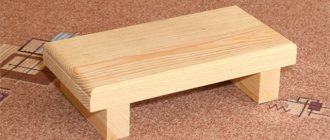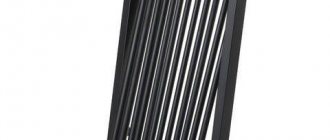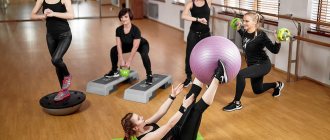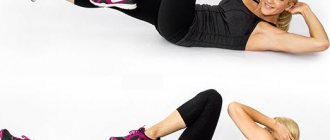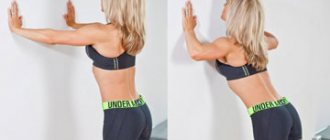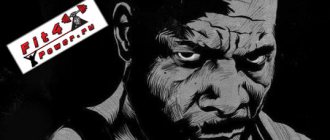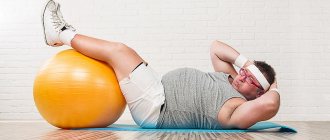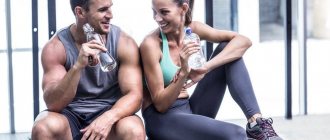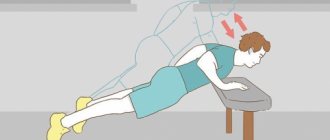Lee Hain Deadlift
Mr. Olympia introduced to the masses an exercise that developed the deltoids, especially the rear fascicles. Its peculiarity is that the barbell row is performed behind the back, and this is very difficult for most athletes to do, and not everyone can feel it. Therefore, the technique is rarely used by athletes.
Read more about the Lee Haney deadlift exercise →
SPORT Top 10 exercises I do in the gym
Bench press
“How much do you bench press?” is a classic question when discussing achievements in the gym, which is not surprising. One of the basic exercises that determines overall strength, in addition to squats and deadlifts. And this is one of the few exercises that remains a favorite after years of training. True, now I will not answer the question mentioned above in its traditional form: “How much do you press at a time?” I haven’t worked on repetitions for a long time, I basically stick to the number of repetitions ranging from 8 to 15 . In addition, I perform the classic bench press once a month at most. The rest of the time I work more with dumbbells and in the Smith machine at different bench angles, in a crossover and on parallel bars. For me personally, a simple bench press is not very effective; it works the shoulders more than the pectoral muscles. In general, the working weight of the barbell is 100-110 kg for 8-12 times in 3-4 main approaches. However, this is one of my favorite exercises.
I’ll give you one piece of advice that personally helped me to relieve my shoulders a little when doing the bench press. Bring your shoulder blades together, then your shoulders will be motionless. By the way, this is a powerlifting technique for performing the exercise, excluding the bridge. I don’t use it, because it reduces the range of motion and simplifies the exercise, and for muscle growth you just need a maximum range of motion. Again, a lot depends on the structure and how the muscles are attached. What is good for one person may not be suitable for another. Therefore, lifting weights is an individual sport in which there are no universal tips. You need to try everything on yourself and choose the most effective exercises and principles.
It’s also worth noting that I don’t have any unfavorite exercises as such.
There are simply exercises that need to be done and that work for me, and there are those that I like more and do with special pleasure. Dumbbell Bench Press
I admit honestly, in the past I practically did not load the pectoral muscles with dumbbells at all, considering this exercise to be useless. When I started working out with a trainer, I did it automatically, like it’s necessary and necessary. But gradually I began to really feel the work of the pecs, and much better than during the barbell press. I especially like the options with different bench angles (30°, 45°, sometimes upside down).
Actually, the main progress in the appearance of the pecs (especially in the upper part, in the so-called “collar”) occurred precisely thanks to work with dumbbells.
Here I will add not only bench presses, but also dumbbell flyes. The reason is simple - when pressing dumbbells, the amplitude is greater, plus the arms are not fixed, they move freely, and I can force the pectoral muscles to work, and not the deltoids, while with a barbell they are fixed in the same plane and here my joint structure is a limitation and features of muscle attachment. Bringing hands together in crossover
I do not recommend this exercise for beginners. They are really better off focusing on basic movements. But I highly recommend it to advanced comrades who want to give a certain shape to their breasts. Crossover raises (from top to bottom), arm lifts (from bottom to top from lower blocks), lying down presses - all these exercises allow you to perfectly trim your pecs, define them and give them an athletic shape. It is important to feel that you are working with your chest, and not with your arms or anything else. There is no movement in the elbows, we use only the chest, specially trying to strain them. If at the end of the exercise there is a burning sensation in the target muscle group, then everything is ok - you pumped your pecs, and not something unclear.
What is good about working in a crossover in comparison with a barbell or dumbbells is that the muscles are constantly under tension , including at the extreme point of the exercise, that is, at peak contraction.
In turn, when bench pressing or dumbbells, when the arms are fully straightened, the load from the muscles goes to the joints. This is why some athletes do not work at full amplitude and do not fully extend their arms. Or, with precise control of the muscles, they tense them at the top point on their own, but this is not easy, it takes a lot of practice. An incomplete amplitude can be used by a less experienced person, but, as you understand, the smaller the amplitude, the worse for the development of the target muscle. The goal is to stretch it as much as possible and shorten it as much as possible, which is impossible when working in partial amplitude. Crossover curls
Almost a classic biceps exercise, with the exception that instead of a barbell I use a block. The reason is exactly the same as in the crossover exercises described above - constant load on the target muscle, including during peak contraction. It is important not to move your torso during the execution, but to work only with your hands, placing your elbows slightly forward and fixing them in space.
I also like to do crossover biceps curls while sitting with my elbows on my knees.
A kind of analogue of curls on the Scott bench. Hammer grip dumbbell curls
I don’t know why, but I just love this exercise that trains the brachialis .
This is the brachialis muscle that runs between the biceps and triceps. It is partially responsible for the peak of the biceps, as if pushing it out when the arm is tense in a bent state. Most often I do it sitting, with my elbows resting. Sometimes I work standing, but in this case I have to especially control my elbows so that they do not move. Dumbbell lateral raises
For a long time, there was a problem with training, or more precisely, with pumping up the deltoid muscles - they did not grow at all. True, among the exercises I only did the classics for them, like lifting dumbbells up, the “Arnold press” or the barbell up press while sitting and standing. I achieved visible results only by including various types of dumbbell lateral raises in the program: sitting, standing, lying on your stomach, plus lifting dumbbells forward. I also added other exercises, including lifting a barbell or block in front of you, rotating the disc and several others. But most of all I like the dumbbell lateral raises.
It is worth noting that the exercise is quite complex and there is no need to use a lot of weight when performing it. It is important to feel the target muscle and strain the deltoids, and not your back, arms or anything else. You need to pull your elbows up, imagining as if you are pouring water from two jugs of water. According to the description, everything seems simple, but it took me several months to learn to feel the muscles when working with dumbbells. The most important thing is not to chase heavy weights; they are not needed in the mentioned exercises and can only do harm, completely breaking the execution technique.
Another factor that personally helped me in training my deltoids (as well as my arms) was changing my training split . Previously, it was classic - three times a week with training of the following muscle groups:
- Legs and triceps.
- Back and shoulders.
- Chest and biceps.
As you understand, after a hard leg workout there was no time for triceps, my strength was running out, and I was frankly slacking. The same goes for back training, especially if heavy exercises like deadlifts were included. And for a comprehensive training of the deltas, it is necessary to pump all three beams separately (back, middle and front). Naturally, it was not possible to do this either.
As a result , I added one more training day and scattered the shoulder training throughout the week . The result is a split for Monday, Tuesday, Thursday and Friday, respectively (the rest of the days are rest):
- Legs (4–5 exercises).
- Back (4 exercises) and rear deltoid (it works in all back pulling exercises, so you just need to finish it off with a couple of movements).
- Pectoral (4 exercises) and anterior delta (similarly, in pressing exercises the front part of the delta is worked, so in the end a couple of movements in 3-4 sets of 12 times is enough to get a good effect).
- Biceps and triceps, plus middle deltoids.
Perhaps my experience will be useful to someone, plus do not forget that from time to time the training program needs to be changed, surprising the body, and giving the muscles an additional incentive to adapt and grow.
I personally am thinking of specializing in hands for the winter. I would like bigger “cans”. Block pull to the chest
Another technically quite difficult exercise. At least for me. It was only when I started working with a trainer that I realized that in the past I was pulling the block with my hands and not with my back. How did you understand? Yes, it’s very simple: no matter how much I did this exercise in the past, the next day or every other day my arms hurt, not my back. Or nothing hurt, which happened more often. It very rarely happened that I felt exactly my back. When I really learned to work in the required amplitude and pull with my back, after each workout the strength was felt in the right place.
To perform the exercise correctly, you need to try to pull your elbows down and not bend your elbows . Imagine that your hands are just hooks, and it’s your elbows that pull the block.
By the way, the same rule applies to wide-grip pull-ups - we lift the body using the back, not the arms. But if the goal is to train the biceps, then you can use your hands to pull yourself to the horizontal bar, but then you should change your grip. In the case of a block, it is better to work only with your back. Specifically for the arm muscles, this is a weak load, which falls more on the ligaments and tendons.
Naturally, I do many other exercises for the upper and middle back, but what I like most are the different types of pull-downs.
Deadlift
To be honest, I never liked this exercise before and did it because “I had to.” But obviously something wasn’t going very well, since often after my heroic attacks on weights that were impressive for me, I received minor injuries in the lumbar region. There were no doctors, but such adventures brought little joy. For a long time I even avoided doing deadlifts, blaming them for my problems, but in fact I had to do them correctly and not strain myself against the weights.
As a result, I returned to this exercise, and it was this that helped solve problems with the lower back (I often ached), plus active abdominal training, simple morning exercises for the back, and another exercise, which is discussed below.
Roughly speaking, I started all over again, that is, with minimal weights, having previously learned the technique of performing the exercise. It is important that the barbell is close to your legs during the entire movement , plus you need to control your lower back - there must be a deflection. Under no circumstances should you hunch your back; in this case, the load falls directly on the spine, which is fraught with injury. If you move the barbell forward from your legs, this also creates an extra and unnecessary load on the lower back.
When I started doing the exercise correctly, I was able to perfectly strengthen my back extensor muscles, plus my lower back stopped hurting.
Although, everything had an impact here, of course. Hyperextension
This is the second exercise that allowed me to strengthen my back well, which I previously avoided doing due to constant lower back problems. Again, when performing it, it is important to control your lower back, bend and straighten smoothly, and do not arch at the top point. In the starting position, the back is completely flat, and not arched; this is the position you need to return to when extending. The legs should be straight and not bend at the knees.
I do hyperextensions once or twice a week with weights.
I hold the pancakes in front of me with my arms half-extended; this is more convenient for me than pressing them to my chest or placing them on my back. I highly recommend this exercise for strengthening the back extensors, and for girls it is also useful for training the buttocks. Leg extension in the simulator
I never liked squats, and in general, training the lower body is not the most exciting activity for me, but I really like leg extensions. I mainly use it either as a warm-up and pre-tiring exercise before heavier movements, such as squats or leg presses. Or as a final finishing touch to the quadriceps muscle after a hard workout. In both cases the effect is great. In the first, the exercise allows you to reduce the working weight in complex exercises, without losing their effectiveness. In the second, pump more blood into the muscle and completely exhaust it. Work at 110%, so to speak.
In the past, it was leg extensions that helped me return to active development of these muscles. When I first started training with a trainer, I just suffered a slight sprain or inflammation of the ligaments just below the knee and completely gave up training my legs because of the pain. But on the advice and under the supervision of a trainer, careful execution of extensions followed by light weights on the legs made it possible to solve this problem within a month. But before that, I suffered with it for three or four months, having tried, according to the doctor’s instructions, all sorts of ointments, and an elastic bandage, and rest, and other “poultices.”
So, if you have discomfort in your knees when doing heavy exercises, then do not forget about a good warm-up, and also try to first fatigue your legs with extensions. Weightlifting bands also help.
Arnold press
Schwarzenegger himself popularized the bench press technique. The exercise involves focusing the load on the front deltoids, which do not relax as the press is performed. This is a kind of symbiosis of the dumbbell press and the military press, and is the most popular unusual exercise for the deltoids.
Read more about the Arnold press exercise →
Zottman Curls
The unusual thing about the exercise with dumbbells is that the bending of the arms occurs when the arms are supinated (with a turn), and the extension is performed in a pronated position. Thus, it includes both flexion with supination and reverse grip.
Read more about the Zottman curl exercise →
Basic leg exercises in the gym
The gym has a large amount of sports equipment with which you can pump up your legs well. Let's pay attention to the most effective equipment and simulators.
Squats
Squats are one of the best exercises for working the lower half of the body. When moving with a barbell, we pump up the muscles of the abdominal area, back, hips and buttocks.
Before you begin barbell squats, be sure to do a warm-up as well as regular squats.
- We place the barbell on the lower part of the shoulders, the hands act as a fixator.
- We place our feet shoulder-width apart or slightly wider, turn our toes slightly outward, keep our back straight, with a natural arch in the lower back.
- As you inhale, perform a squat so that your knees spread out to the sides in the same directions as your toes point, while your gaze is directed forward.
- We begin to rise, using the pelvis, straightening our legs and the entire body. The moment of greatest tension is accompanied by exhalation.
Performing squats with a barbell
Don’t try to lift as much weight as possible; the main thing in this exercise is proper technique.
Video: How to squat with a barbell correctly
Front Squats
Squats with a barbell on the front allow you to remove excess stress from the spine and, at the same time, effectively work out the lower back, stomach and lower limbs. This exercise helps build the following muscles:
- quadriceps (they do most of the work)
- core muscles
- abdominal muscles
- calf
- gluteal
The exercise is performed as follows:
- We approach the power frame, adjust the height of the racks so that it is at shoulder level.
- We put the bar down and load it.
- Taking a step forward, we place our shoulders under the bar.
- Cross your arms and place them on top of the bar. Having removed the projectile from the racks, we step back a little.
- We place our feet shoulder-width apart, spread our feet slightly to the sides, and tense our abdominal muscles.
- Straightening your back, rest your feet on the floor, inhaling, begin to squat smoothly and under control until your thighs are parallel to the floor.
- We make a powerful push with our heels, straighten our legs and return to the starting position.
Muscles used during front squats
Thanks to the position of the barbell, the exercise is safe for the back and knee joints. And such squats are perfect for those who want to lose weight.
Video: Technique for performing front squats
We pump the quadriceps femoris muscle. Leg press in the gym
The following muscles are particularly involved in the leg press:
- quadriceps (quadriceps femoris)
- inner and back thighs
- gluteal
In this case, the back and abdominal muscles are not involved in the work.
The leg press is great for developing muscle definition in the legs. And despite the fact that this exercise seems simple to many, it is considered one of the most traumatic. There is no need to tear the veins on it, trying to take the maximum weight. The number of repetitions must be at least 10, which means the weight must be selected accordingly.
- We press our back completely against the exercise machine, and place our legs at an angle.
- We bring the platform up, fully straightening our knees.
- We clasp the handles of the exercise machine with our hands.
- We inhale and smoothly return the platform down as far as possible. The lower back does not come off the simulator. The main weight of the platform falls on the heels; the knees do not fall inward.
- Immediately exhale and press the platform up.
Press
Do not raise the platform to the maximum and do not straighten your knees completely.
Video: Performing leg presses in a machine
Hack squats are the best exercise to pump up your quadriceps.
This type of squats is not generally known, but this in no way diminishes its practical benefits for the muscles of the legs, hips and buttocks. Hack squats are especially good at pumping up the quadriceps, allowing you to build a massive front thigh. The exercise is performed on a special simulator.
- Sit under the machine, placing your shoulders under the shoulder pads and leaning your back against the backrest, but leaving a natural lordosis in your lower back.
- We place our feet shoulder-width apart in the middle of the platform. Feet parallel to each other, gaze ahead.
- Remove the retaining stoppers and straighten your legs.
- Inhale and smoothly lower the platform, bending your knees.
- We sit down just below parallel with the floor.
- We push off the platform with our heels and press the weight up without sudden movements.
- Straighten your legs and return to the starting position.
Hack squat technique
The advantages of hack squats are safety and ease of execution.
Video: Hack squats with a barbell
Lunges with dumbbells at home
Another effective exercise for the quadriceps and gluteal muscles is lunges with dumbbells. An excellent exercise to perform both at home and outside the home. They can be done both on the spot and on the move. In the second case, the working leg can step forward and go back (a more complex option) or step back and go back forward (a simpler option). Lunges can also be done by walking if you have enough space.
- We take two dumbbells, stand up straight, place our hands with dumbbells on the sides of the body, look in front of us.
- While inhaling, we take a step forward with our right leg and sit down so that it is bent at the knee at a right angle, and the shin of the left leg is parallel to the floor.
- We fix the lower position and, as we exhale, begin to lift ourselves using the quadriceps. We do not straighten our knees completely.
- As you inhale, lower yourself again so that the shin of your left leg is parallel to the floor.
- We perform 3 sets of 10–12 repetitions and change legs.
Lunges with dumbbells work all the major leg muscles
Performing lunges with a step forward helps to lose weight, but, at the same time, requires careful treatment of the knee joints.
Video: Technique for performing lunges with dumbbells
Leg extension in the simulator
This basic exercise is not suitable for increasing the mass of the quadriceps, but it will perfectly outline their relief and shape. It is often recommended for beginners to prepare muscles for technically more complex exercises.
- We sit on the exercise machine, pressing our backs against the backrest and placing our legs behind the bolster.
- We grab the handles of the exercise machine with our hands.
- Raise your toes up.
- Exhaling, we straighten our legs at the knees.
- We strain our quadriceps and fixate in this position for a couple of seconds.
- Inhaling, we smoothly lower our legs without relaxing them completely.
- We perform 3 sets of 15–20 repetitions.
Classic leg extension on a machine
The exercise puts serious pressure on the knee joints, and therefore, when performing it, it is extremely important to monitor your technique and not use too much weight.
Video: Technique for performing leg extensions in the simulator
Lying leg curls
Lying leg curls are great for training your calves and biceps femoris. Thanks to its simple technique, it is recommended for both experienced practitioners and beginners.
- We lie face down on the machine, placing our legs under the bolsters.
- We press our pelvis against the bench, grab the handles with our hands, and look at the floor.
- We strain the muscles of the abs and buttocks.
- We inhale and, as we exhale, sharply tighten the rollers, almost touching the buttocks.
- We fix this position for a couple of seconds.
- Inhaling, we slowly lower our legs.
- We perform 4 sets of 15 repetitions.
Lying leg curls
Make sure your knees are hanging off the bench and your hips are not moving away from it.
Video: Leg curls in a lying machine
Deadlift
There are several variations of the deadlift, all of which are excellent exercises for training your legs. Let's look at two types of traction that most strongly affect the lower body.
Sumo deadlift
This row allows you to lift more weight compared to the classic exercise, due to which the leg muscles, especially the hip adductors, are more involved here.
- Place your feet at a distance of approximately two shoulder widths from each other.
- We sit down until our thighs are approximately parallel to the floor, and grab the barbell using an upper-medium grip, that is, our hands are positioned slightly wider than our shoulders.
- The back is straight, a slight natural arch in the lower back.
- We bring our shoulder blades together and push our chest forward.
- As you exhale, we lift the barbell, activating the leg muscles.
- Straighten your back and hold it for a couple of seconds.
- As you inhale, smoothly return the bar to the floor.
Sumo Deadlift
Romanian deadlift
This type of deadlift maximally engages the erector spinae, gluteus maximus, and hamstrings muscles. In addition to working on strength, it provides stretching for the back of the legs. It is advisable to move on to this exercise with good flexibility and after mastering the classic deadlift.
- We place our feet shoulder-width apart.
- We grab the bar with an upper middle grip.
- We slightly bend our elbows and knees, bringing our shoulder blades together while keeping our back straight.
- We move our pelvis forward, bend our back, move our buttocks back and bend.
- As you exhale, we begin to lift the barbell using the strength of the hamstrings, keeping the bar as close to the legs as possible.
- Without jerking, we lift the barbell to the middle of the thigh.
- Let's fix this situation.
- As you inhale, lower the barbell without bending your legs too much.
Deadlift on straight legs
Calf raises in the gym
Due to the additional weight, a simple exercise turns into quite effective.
- We approach the simulator and place our shoulders under the supports.
- We stand on the edge of the lower platform, legs slightly bent at the knees.
- We activate the simulator and press our legs down as much as possible, stretching the calves, while keeping the back straight.
- Exhale and raise your heels, tensing your calf muscles.
- Using the muscles of the lower leg, we rise as much as possible and fixate in this position for a couple of seconds.
- Inhaling, we slowly return to the starting position.
- We perform the exercise in 3 sets of 15–20 repetitions.
Calf raises in the gym
It is recommended to use a weight of 20–30 kg for a man, and 10–20 for girls.
Video: Performing calf raises in the simulator
Turkish Rise
This exercise comes from kettlebell lifting. His unusual technique involves the athlete getting up from the floor and returning to a prone position, holding the kettlebell vertically with a straight arm without changing trajectory. Lifting develops most of the muscles in the body.
Read more about the exercise Turkish kettlebell lift →
Basic
T-bar chest push
It is not necessary to use a handle like in the picture. You can simply hold the bar with both hands.
Brief technique: When pushing, tighten your pectoral muscles, not your shoulders and triceps. To do this, when pushing the T-bar, you need to lean your body back a little (as in the picture). When lowering onto your chest, return to the starting position.
It is also possible to push the T-bar with one hand
(for one-way training).
The technique is similar to an exercise with two arms: when pressing, we lean back a little, and when relaxing, we return to the starting position.
Pancake bench press or Svend press
We hold it exactly as shown in the picture (you can insert your thumbs into the holes so as not to drop the disc). This position of the palms allows you to load the pectoral muscles a little more.
Brief technique: lower to the pectoral cavity (bottom of the chest), raise slightly diagonally (arms are not strictly vertical above the shoulder joints, but look up and forward, i.e. the pancake is above the chest).
Can be performed with dumbbells
Standing plate (discus) press.
The exercise can be performed in two ways: A). Press strictly horizontally (as shown); B). Press 1 time slightly up diagonally, 1 time horizontally, 1 time slightly down diagonally.
The second variation is more difficult. Its use is relevant after the first one stops working. In general, the exercise allows you to work out the internal parts of the pectoral muscles.
Brief technique: straightening your arms with the disc in front of you, specifically strain your pectoral muscles (as if you want to squeeze them); returning the disc to the sternum, spread your elbows wider (do not keep it near your body!).
Bench press on the floor.
I have seen such an exercise more than once by Andrey Sukharev - “Animal from Irkutsk”. It is used to pump up the chest and overcome the “dead point” in the upper phase (a kind of analogue of push-ups, only with slightly lighter weights). The floor does not allow you to lower the barbell to your chest (elbows below the floor), which is why the range of motion is reduced and more repetitions can be done. More repetitions is myofibrillar muscle hypertrophy.
Brief technique: legs bent at the knees, feet on the floor. Squeeze the barbell until your arms are straightened (almost completely), bend them, touching your elbow joints to the floor (but do not put your elbows on the floor!).
Standing leg raises in the simulator
The case when the exercise appeared when performing a technique using a simulator for other purposes. If there is a special seat, which is provided for comfort and stabilization of the torso and pelvis, the exercise is performed without contact of the pelvis with the seat.
Breeding legs in the simulator →
Free snippet - 100 ideas for unusual PE homework assignments
Introduction
Many are already accustomed to the fact that homework in physical education is not assigned, unless they usually write in their diaries: “Bring your uniform,” nothing more. Occasionally, only the guys are asked to write an essay or something similar. But why not expand students’ knowledge by touching on as many diverse and unusual topics related to physical education and sports as possible? It is quite possible. This guide will give you as many as 100 ideas for such unusual homework assignments. It’s up to you to decide what and in what class to teach. Many tasks can be simplified or complicated depending on how deep you decide to go into the topic. Accordingly, the tasks will be simpler for kids and more difficult for high school students.
It’s worth clarifying right away that if we are talking, for example, about preparing a story, then this can be both the submission of written work and an oral report. And, of course, it is clear that we cannot listen to the stories of all students, so this type of task can be given individually. Then, for each lesson, one selected student will prepare such a message. So gradually all the guys will go around in a circle, trying their hand at preparing a story. Or you can highlight part of the lesson so that all the children briefly share what they have prepared. It all depends on how the lessons are usually structured, how much time the children spend on this or that activity, how many people are in the class, how organized they are.
Each class may have its own nuances, so before assigning homework, consider how you will check and grade it. All these conditions need to be discussed with the guys in advance.
Now it's time to get down to business! Get acquainted with the proposed ideas, see what your students might like, what will arouse their interest, and what is best left for the future. And don't be afraid to come up with something of your own! No one knows your class better than you!
Homework options
1. Talk about the chosen or given sport
A specific sport is given, for which a story needs to be prepared. What type it will be depends on the class and the preparation of the students. In elementary school these may be common words. For example, “football is played with a ball”, “the task is to kick it into the goal”, and so on. In middle and high school, these may already be more serious and detailed messages - the history of the appearance, the nuances of the game, etc.
If we are playing a certain sport at this time, then it is better to talk about it. If you want to raise general topics, let the kids themselves choose which sport to write about. Let's say, if the Olympic Games are coming soon, then we can talk about summer or winter sports. The World Hockey Championship is taking place - let them talk about this sport, etc.
2. Tell about the selected athlete
Prepare a story about the selected athlete. It is advisable that the guys talk not just about the athlete, but also why they chose him/her, what attracted them to this particular person. The story should be short but informative so that everyone gets a full understanding of who is being talked about.
3. Tell the rules of the game at home
In our lessons we learn the rules of various outdoor and sports games. When we go through a new game, you can give the students the task of telling the rules of the game at home, and let the family evaluate how much they understood these rules, how much they understood. Just don’t scare either parents or children with the assessment, let it be for fun. Parents give a rating from 1 to 5. And then it will be interesting and fun to compare who received what. Accordingly, who completed the task and how. It is only advisable to warn parents so that they judge honestly and not be afraid for their children. Therefore, we immediately clarify that neither a bad nor a good grade will go into the journal (unless the task is not completed at all). This task is given in order to check how the child understands the rules and how he can explain them, and not in order to give a bad grade.
4. Prepare a plan for an outdoor or sports game
Once a new game has been mastered, you can assign the team or individual students to prepare a specific game plan. For example, we learned the game “Tails,” a version of a team game. Let the guys on the team think through and describe a plan for the next game. What can you come up with in order to win, how to distribute responsibilities, who should act and how, etc. That is, you need to thoroughly work out the rules of the game, draw conclusions and use all the strengths of your players. In the next lesson, these plans can be tested in practice. At the end of the lesson, by joint decision of the team, you can decide what grade to give to the student who planned the actions. If the plan was prepared by the whole team, then the entire team is assessed by its opponents. It turns out that the rivals will evaluate each other. Or the teacher makes the decision as the main judge.
5. Come up with new rules for well-known outdoor games
Outdoor games are often used in physical education lessons. Usually guys love to play and easily remember the rules. So let them now try to figure out for themselves how the usual rules can be modified or altered in order to diversify the games. There can be many options. At the next lesson, you can try out variants of the new rules and choose the one that everyone likes more than the rest. Or see who can come up with the most different options.
There are a large number of games used in school lessons, so there will be a large selection. In addition, you can let the children think about sports games: what could be invented to make a certain sport more attractive and entertaining.
6. Come up with deceptive movements
It is better to give this task to the children when passing or exercises with the ball took place in the lesson. In this case, you need to come up with individual actions to deceive the enemy. That is, the task is to make some tricky movement or series of movements in order to confuse the opponent and not give him the ball or slip past him, etc. Every invented deceptive action must be written down and be ready to show in practice. The more such movements are invented, the better. But at the same time, it’s better to work on one or two well than ten superficially.
7. Come up with a combination for a game or exercise
This task is given to two, three or four players. The guys' task is to think of some combination to beat one or two opponents. It is interesting to ask the children to outline the actions of the players, and then the teacher could use these plans to see what was planned and how it was implemented. You can think of several combinations, not just one.
If we talk about exercises, then the task here is somewhat different: you need to think about what exercises can be done in twos, threes, fours with the ball. This task is easier to check. The guys will take turns showing what they came up with. Then we discuss which exercises can be considered the most useful and interesting, based on what topic is being covered at the moment. In the future, the most optimal exercises can be continued in subsequent lessons.
8. Let's draw physical education
There may be several options here. For example, we give the task: “Draw physical education.” Let the kids decide for themselves what to draw. From the drawing it will then be possible to judge what the children remember better, what they associate physical education with, etc. Another option is when a specific task is given, what needs to be drawn: a specific sport, movement, exercise, equipment, etc. Difficulty What you need to draw depends on which class you are teaching. In elementary school you can draw something simpler, in middle and high school it’s more complicated. If the lesson is held at an art school, then the children can be given a more difficult task - to draw everything in more detail, and even with athletes or students.
9. Watching competitions
This task is best given when some important matches, big competitions are taking place - the Olympics, the World Cup, etc. The children’s task is to watch as many reports as possible, and then write a report on the event they watched. The complexity of the report will depend on the class. Children in elementary school can simply say what they watched: what sports, who participated, who won, etc. But older children can easily give a more detailed report: who played, what tactics were used, who judged, how successful the refereeing was , how many spectators there were... In general, the more details you can note, the better. You can even hold a kind of additional competition - which of the guys will be able to note various details the most.
10. Remember and draw a flag
This time the task is to watch the competition and remember the flag of a country (preferably two or three). You can also sketch these flags. In this way, the children will get acquainted with the flags of other countries and show their powers of observation. And if they choose longer, they will look at many different flags and will probably remember some of them. Then during the lesson you can show students pictures of different flags and ask them to find out which flag belongs to which country.
11. Remember the anthem
The same option as with the flag, but now the children’s task is to remember the anthem of a country. Of course, here the choice will not be so rich. Anthems are most often played at international matches or when the winners' flags are raised. However, you can give the children the task of finding the anthem of the country they like. It is clear that not everyone can sing the anthem (unless, of course, we have a music school), but trying to tap out the desired rhythm is quite possible. In addition, you can learn the name of the hymn and general words (you don’t have to learn the entire hymn, you just need to understand the main content).
12. Select sports based on a specific characteristic
The task is to select as many sports as possible with a ball, a net, a stick, skis, without any objects, using special equipment for movement, associated with water, involving animals, etc. Select team or individual sports, and so on . That is, we set the sign, and let the guys search/remember and write it down. The longer the list, the better.
13. Prepare equipment for games
When the rules of an outdoor game in which certain equipment is present are learned in class, you can give the children the task of preparing this equipment for this game at home. For example, bags or soft balls for throwing, headbands or headdresses in the form of a cat, dog, geese, etc., depending on the game, red and blue noses (for the game “Two Frosts”). Collect cones, acorns, nuts for the game of the same name. Make a ponytail that can be hidden behind the elastic band of your pants. There may be a large number of options, but basically, of course, this will be a task for elementary school.
14. Prepare a gymnastic combination
During the lesson, various elements from acrobatics and artistic gymnastics are studied. To ultimately test how guys handle them, gymnastic combinations (or compositions, as they are sometimes called) are best suited. The task will be not just to collect the elements in one pile, but to make sure that the elements flow logically, one after another, with beautiful transitions. Ultimately, you can evaluate the execution of the elements separately, and the logic of constructing the combination separately.
Before giving such a task, the guys need to be familiarized in general terms with how combinations should be composed in general - how to logically move from a somersault forward to a bridge, etc.
Combinations can be assessed by the teacher himself or by the whole class. That is, the class watches and grades the combination itself, and the teacher evaluates the correctness of the elements.
Combinations can be made for floor exercises (on gymnastic mats), exercises on the horizontal bar, rings, gymnastic beam, uneven bars, etc.
15. Take photos
This kind of homework is best done during the holidays. Let the children try to take different photographs dedicated to their active recreation. What can be in the photo: cycling, water skiing, playing football, volleyball, just walking in the forest, playing outside, etc. After the holidays, you can get together and make a photo exhibition so that everyone can see what they can do during the holidays and how to rest.
16. Exercises for pets
Think about what exercises you can give your pets. Of course, these will be theoretical exercises - you shouldn’t torture animals at home by experimenting on them. Perhaps in the future, after analyzing the invented exercises, you can decide whether such exercises are worth giving or not. That is, the task of the guys is to logically think through what exercises can be done with the pet and how all this could be organized. If the student does not have a pet, let him choose one and figure out what he can do with it.
17. Learning to hold your breath
For swimming and just for ourselves, we train to hold our breath for as long as possible. First, have students try to determine their maximum, and then they are given a week to a month to prepare. At the end of the training time, let the guys try again to see what they can do. Will they be able to surpass their initial result or not? It is convenient to check the completion of this task only if our classes are held in the pool, when the children can dive and stay under water. Without water, it is quite difficult to track who is still holding their breath, and who is already starting to inhale slightly.
18. Remember the time period(s)
There is such an exercise - memorizing time periods. The teacher gives the command: “Attention! March!" and counts down 15–20 seconds. The guys try to remember this period. Just they don’t count out loud, but everyone decides for themselves how to do it: maybe mentally counting or in some other way. Then, when they have tried to remember once, the command is given again: “Attention! March!”, but now the guys themselves are trying to count down the required period of time. When one of the students thinks that time is up, he raises his hand or takes a step forward. The teacher looks to see who can count more accurately than the others.
It’s best to do this exercise with your eyes closed so that the guys don’t focus on each other. In the future, you can carry out the exercise while walking or even performing some simple additional task - raising your arms up, making circular movements with them, etc.
When the exercise is learned, the children are given a homework assignment to practice remembering a certain period of time - 15, 20, 25 seconds. Then, at the next lesson, you can check who can more accurately demonstrate what they learned at home. Now the exercise is carried out without repetition. The command is given immediately, and the children themselves count down the required time.
With older kids, you can try to memorize longer periods, even 20–30 minutes. For example, the lesson begins, and when 20 minutes have passed, the guys must say about it. Everyone speaks when he considers it necessary, the teacher writes it down or remembers it, and when everyone has expressed their opinion, then he sums up who turned out to be more accurate.
At the beginning, it is better to memorize even intervals in increments of five seconds, later it is better to give uneven numbers - 17, 19, 23 seconds, etc.
19. Prepare a quiz
This task can be given not to one child, but to a group of children. The guys prepare interesting questions related to a certain sport, physical education, the Olympic movement, maybe even about past physical education lessons - the topics can be any. The quiz is held throughout the lesson. That is, a short pause is given after the next task, one of those preparing comes out and asks one or three questions. The guys raise their hands and answer (they call on those who raised their hands faster, or those who have not yet been asked to answer). Anyone who answers correctly receives one point or an extra point, which is then added to the final score.
And so every pause. The teacher himself needs to decide how many questions to prepare. It is important that there are enough of them and at the same time that they do not take up too much lesson time. It’s better if there are more questions, then they can be left for the next lesson.
20. Prepare lotto
A slightly different option is to prepare a lotto. Also, a group of children is preparing lotto, which can then be played in class.
Let's figure out what this lotto requires.
First, you need to prepare cards, divided into 6-8 squares. On each card, 3-4 squares are filled in - you can put numbers or write the names of sports.
The second is to prepare pieces of paper with the numbers and names of sports (you can also use pictures depicting them).
Third, coins or circles to cover the numbers on the cards.
The guys receive one or two cards. The conductor (optimally two) begins to take turns taking out pieces of paper with the numbers and names of sports and calling them out loud. They take turns to make sure everything happens as quickly as possible. Whoever closes his card raises his hand up and reports this with the word “finished.” The first person to finish gets one point.
You can play the game two or three times during a lesson. Moreover, the one who has already won once does not participate further, giving the others the opportunity to win.
21. Prepare a video riddle
To imagine what needs to be done, you can remember the program “What? Where? When?”, in which one of the viewers asks a video question. In our case, the child’s task is to come up with and prepare a question related to physical education or sports, record it on video or demonstrate it (as for recording) live. The whole class (like experts on a game show) deliberates and gives an answer. If you divide the guys into groups, then it is better for each group to give their answer. If the class solves the riddle, then everyone receives one-fourth of a point (in total, four questions can be given for the lesson, then if you solve everything, you can get an additional point, if not all, then a plus to the grade received). If the class does not guess, the asker receives plus one point (provided that the teacher judge considers that the question is good and was really related to physical education and sports or the given topic).
In order for everyone to try themselves in the role of asking a question, it is better to give the task several lessons in a row, but each time for different children.
22. Prepare a cartoon
The point is that children, using computer programs or even ordinary drawings, can make a cartoon dedicated to physical education and sports. The topic is chosen by the teacher himself, or this right is given to the student. Such a cartoon can be made even using phones with good cameras. It will be enough to make drawings and shoot them, assembling them into a cartoon.
The length of the cartoon is agreed upon in advance, but this is not necessary. Let each child choose what and how to do. The cartoon can be anything - just a correct run-up (demonstration of execution technique), a jump, an episode of a game, a shot on goal, or even a longer scene. Complete freedom of creativity on a given topic.
23. Ask your parents what they studied in physical education lessons
Ask your parents and find out from them what they once went through in physical education lessons at school: what exercises they did, what form of teaching there was, what skills they studied, what games they played, how many students there were in the classes, whether boys and girls were separated , what they did, etc. Let the guys try to learn as much as possible. It will be instructive and interesting.
24. Prepare exercise/warm-up
The task is to prepare a complete warm-up or exercise for the next lesson. The student who receives such an assignment must know what lesson he is preparing for, that is, he will select warm-up exercises that fit the content of this lesson. He needs to write down - or even sketch - the exercises he chooses. Everyone receives such an assignment for their lesson. For each lesson, one student is appointed as the main teacher, two as reserve. That is, if the main one gets sick or does not come for another reason (or is not ready), one of the reserves must replace him. A student who fails to complete his exercises/warm-up on time (due to lack of preparation and no other reason) receives a grade one point lower the next time he does prepare.
The teacher evaluates the notes (in the lower grades you should not strictly judge the form of recording or drawings), the confidence and clarity of the presentation, and the selection of exercises. In elementary school, you can do just a few exercises (3-5), but in middle or high school, children should already be able to do a full warm-up.
25. Prepare special or preparatory exercises
In middle and high school, children can be given the task of coming up with special preparatory exercises for learning any new exercises or elements. That is, for example, in the next lesson we will learn how to do a kip-up on the bar. Let the guys think and find exercises that will help students prepare. The more they can come up with or pick up, the better. This task can be completed by several students or even the whole class. During the lesson, everyone will be able to discuss the selected exercises together and choose those that seem most suitable.
This task will help children learn to think through and imagine new options for exercises and elements, as well as imagine how they can prepare for them.
26. Prepare a lesson
This task is already for high school. Now the student receives a lesson plan and must prepare according to it completely and completely - this is the warm-up, the main part, and the final part. That is, everything is in full without any discounts. Everything should be calculated in terms of time and number of exercises. The teacher, of course, helps and supports the student if necessary, but in general the student still has to teach the whole lesson himself. If we have boys and girls separated, then some of the girls prepare their own activity, and some of the boys prepare theirs.
27. Girls prepare an activity for boys, boys for girls
Stepping onto a bench with a backward lunge
Another option that includes two in one is stepping onto a hill and lunging back. The exercise is not common, but it can be an excellent option for increasing endurance and losing weight.
Learn more about the backward lunge exercise →
Exercises with TRX
Almost any exercise with loops is already difficult and rare. I can't pinpoint a specific technique that will stand out from the list of available trx exercises. Planks, push-ups, pull-ups, flexion and extension are already a unique technique for the exercises we are used to in the gym.
More about TRX loops →

